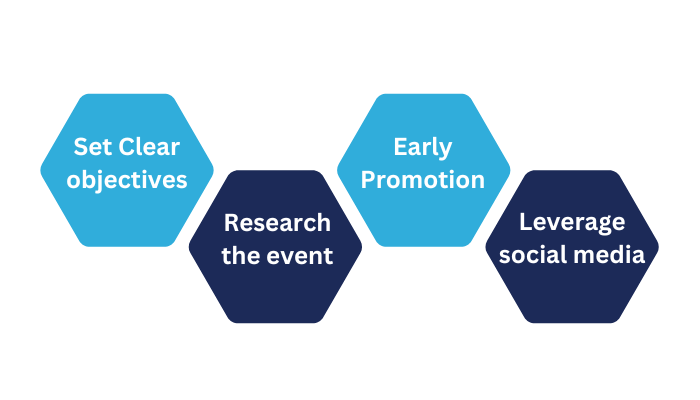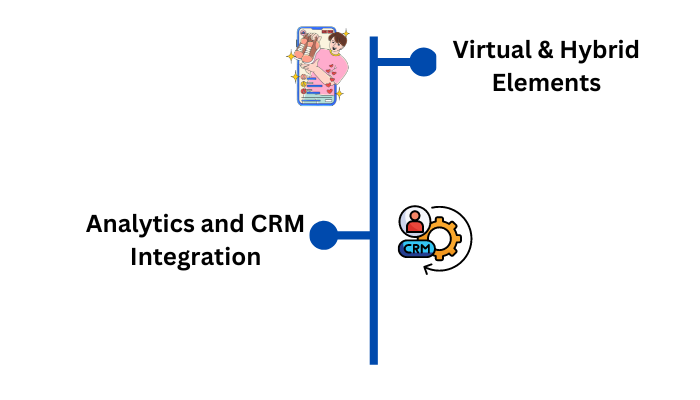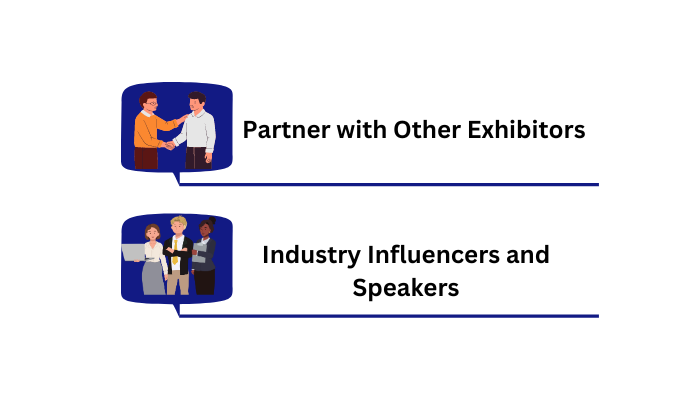Table of Contents
Effective Marketing Tactics for Trade Show Success: Key Strategies

Navigating the bustling aisles of a trade show can feel like walking through a city at peak hour: every turn offers a new sight, a new sound, a new opportunity. For businesses, a trade show is the ultimate platform to showcase their brand, products, and services to a concentrated audience already interested in their industry. Yet, with so many companies vying for attention, standing out among the crowd requires more than just showing up. It demands a well-thought-out, guerilla marketing strategy that engages potential customers before, during, and after the event.
In today’s competitive market landscape, achieving success at a trade show is both an art and a science. It involves a blend of creativity, planning, and the savvy use of technology to create memorable experiences that resonate with attendees. Whether you’re a seasoned exhibitor or planning your first appearance, understanding and implementing effective guerilla marketing tactics is crucial for maximizing your return on investment. From leveraging social media buzz to creating standout booth designs and engaging follow-up campaigns, this blog post will explore the key strategies that can help your business achieve success. Join us as we delve into the world of trade show marketing, where every interaction counts, and making a lasting impression is the name of the game.
Trade shows are a unique and powerful guerilla marketing tool for businesses of all sizes. They offer an invaluable opportunity to showcase products, network with industry professionals, and gain insights into market trends. However, to maximize the benefits, businesses need to implement effective marketing tactics. This blog will delve into key strategies to ensure trade show success, providing actionable insights for your next event.
Also Read :- The 10 Must-Visit Trade Shows of 2024
1. Pre-Show Planning and Promotion

Set Clear Objectives: Before participating in a trade show, it’s crucial to define clear, measurable objectives. These could range from generating a specific number of leads, increasing brand awareness, launching a new product, or establishing partnerships. Having well-defined goals will guide your strategy and help measure success.
Research the Event: Not every trade show is created equal. Research about the event well to ensure it aligns with your industry and target audience. Look at the attendee demographics, previous years’ performance, and the presence of competitors. This information will help you tailor your approach and set realistic expectations.
Early Promotion: Start promoting your presence at the trade show well in advance. Utilize your website, social media channels, email newsletters, and press releases to inform your audience about your participation. Create a sense of anticipation by sharing what they can expect from your booth, such as product demonstrations, exclusive offers, or special guest appearances.
Leverage Social Media: Social media is a powerful tool for pre-show promotion. Use event-specific hashtags, create countdowns, and engage with other attendees and exhibitors. Platforms like LinkedIn, Twitter, and Instagram are particularly effective for reaching a professional audience and building excitement around the event while supporting your corporate event planning strategy.
2. Booth Design and Engagement
Eye-Catching Booth Design: Your booth design is the first thing attendees will notice. Make it visually appealing and reflective of your brand identity. Use bold graphics, engaging displays, and clear signage. Consider the layout to ensure it is inviting and allows for easy traffic flow. Interactive elements, such as touch screens or virtual reality experiences, can also attract attention.
Staff Training: Your booth staff are your frontline representatives. Ensure they are well-trained, knowledgeable, and enthusiastic. They should be able to engage visitors, answer questions, and convey your brand message effectively. Role-playing scenarios and providing them with a clear script can enhance their confidence and performance.
Interactive Demonstrations: Live demonstrations are a powerful way to showcase your products or services. They provide a tangible experience for attendees, making your offerings more memorable. Ensure your demos are well-rehearsed, highlight key features and benefits, and encourage audience participation.
Giveaways and Contests: Giveaways and contests can draw crowds to your booth and create buzz. Choose promotional items that are relevant to your brand and useful to attendees. Contests that require participants to engage with your booth, such as trivia games or social media challenges, can increase interaction and lead generation.
3. Engaging Attendees at the Trade show

Personalization: Personalized interactions can make a significant impact. Use data from pre-show registrations or social media interactions to tailor your approach. Address attendees by their names, reference their company or industry and suggest solutions that meet their specific needs.
Lead Capture and Management: Efficient lead capture is essential for post-show follow-up. Use digital tools like QR code scanners or mobile apps to collect contact information quickly and accurately. Categorize leads based on their level of interest and potential value to prioritize your follow-up efforts.
Host In-Booth Events: Hosting mini-events within your booth, such as workshops, product launches, or expert talks, can attract more visitors. Promote these events in advance and schedule them at different times throughout the trade show to maintain a steady flow of traffic.
4. Post-Trade Show Follow-Up
Timely Communication: Follow up promptly with the leads you’ve collected. Send personalized thank-you emails, address any specific questions they have, and provide additional information about your products or services. A timely follow-up demonstrates your commitment and keeps your brand top-of-mind.
Measure and Analyze: Evaluate the success of your trade show participation against your initial objectives. Analyze metrics such as the number of leads generated, social media engagement, and overall ROI. Use this data to refine your strategy for future events.
Nurture Relationships: Building lasting relationships is one of the most valuable outcomes of trade shows. Continue to engage with your new contacts through regular communication, such as newsletters, product updates, and invitations to future events. Personalized interactions will help convert leads into long-term customers.
5. Leveraging Technology

Virtual and Hybrid Elements: Incorporating virtual and hybrid elements can expand your reach beyond the physical event. Live-stream product or service demonstrations, offer virtual tours of your booth and engage with online attendees through webinars and Q&A sessions for added personalization. This approach can attract a global audience and provide additional content for post-show marketing.
Analytics and CRM Integration: Utilize analytics tools and integrate your lead capture with your CRM system. This will streamline data management and provide deeper insights into attendee behavior and preferences. Leveraging this data can enhance your follow-up strategy and improve future trade show performance.
6. Sustainability Practices at Trade show
Eco-Friendly Booth Design: Sustainability is increasingly important to attendees. Use eco-friendly materials for your booth design, reduce waste, and implement recycling initiatives thereby promoting sustainability. Highlighting your commitment and collaboration to sustainability can enhance your brand image and attract environmentally conscious visitors.
Digital Alternatives: Reduce printed materials by offering digital alternatives, such as e-brochures, QR codes for information access, and digital business cards. This not only supports sustainability but also caters to tech-savvy attendees who prefer digital interactions.
7. Collaborations and Partnerships

Partner with Other Exhibitors: Collaborating with complementary exhibitors can enhance your presence and reach. Joint promotions, co-hosted events, or shared booths can attract a broader audience and create a more engaging and personalized experience for attendees.
Industry Influencers and Speakers: Engage industry influencers or invite respected speakers to your booth. Their presence can draw crowds and lend credibility to your brand. Promote their participation in advance to maximize attendance and engagement.
Conclusion
Trade shows offer a unique platform to engage with potential customers, showcase products, and build industry relationships. However, success requires strategic planning, engaging booth design, effective attendee interaction, and thorough post-show follow-up. By leveraging these key tactics, businesses can maximize their investment and achieve their marketing objectives.
Implementing these strategies requires time and effort, but the rewards in terms of brand visibility, lead generation, and market insights are well worth it. Start planning your next event with these tactics in mind and watch your business thrive in the competitive trade show environment.
To know more and dive deeper into the world of events, contact us.
Also Read:- 7 tips to get your business noticed before, during, and after a trade show!

How to Dominate WHX and WHX Labs 2026 Like a Pro
Executive Summary / Key Takeaways: 12% increase in pavilion space for Germany, China, and Korea at WHX and WHX Labs 2026 signals market dominance 30% increase in dual-presence exhibitors shows scaling from...
